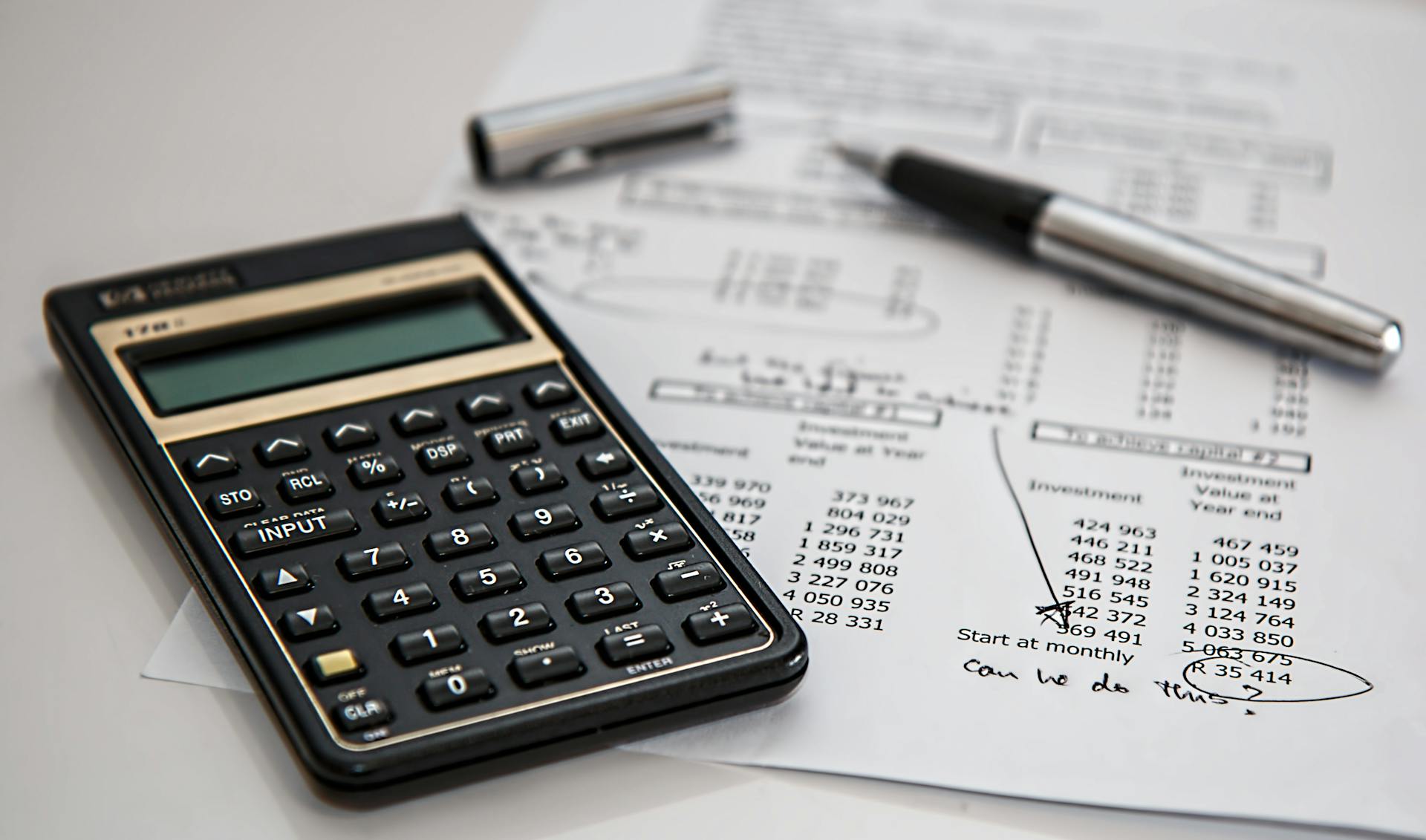
Prepaid rental expenses can be a bit tricky to navigate, but understanding how they work can save you a lot of time and stress.
Prepaid rental expenses are typically recorded as an asset on the balance sheet, and they're amortized over the rental period. This means that the expense is spread out over the time period of the rental agreement.
To accurately report prepaid rental expenses, you need to determine the unamortized balance at the end of each accounting period. This involves subtracting the amortized expense from the initial prepaid amount.
Check this out: Rental Income and Expenses
What Is Prepaid Rental Expense?
A prepaid rental expense is a good or service that has been paid for in advance but not yet incurred, such as rent.
This type of expense is recorded as an asset on the balance sheet because it represents future benefits, just like a prepaid expense.
Rent is a common example of a prepaid rental expense, and it's usually received over the course of several accounting periods.
The value of a prepaid rental expense is expensed over time onto the income statement, similar to other prepaid expenses.
Recording
Recording prepaid rental expenses requires some finesse, especially when it comes to allocating those expenses over time. You see, if you record a prepaid expense as an expense in the first month, it won't match up with the revenues generated from its use.
To avoid this mismatch, you should record prepaid expenses as an asset, specifically as a prepaid expense account. This is a crucial step, as it allows you to allocate the expense over the full period, rather than just in the first month.
The process of allocating prepaid expenses is called amortization, and it's essential to do it accurately to ensure your financial records are correct. You'll need to divide the total prepaid expense by the number of months it covers, and then make adjusting entries each month to record the expense.
Here's an example of how to calculate the monthly expense: if you prepay $9,000 of rent for six months, you'll divide $9,000 by 6 to get $1,500. This means you'll need to make adjusting entries each month to record $1,500 as an expense.
For your interest: Deferred Expense vs Prepaid Expense
To make an adjusting entry, you'll debit the expense account and credit the prepaid expense account. This will reduce the asset account and record the expense for the current month. You'll repeat this process each month until the prepaid expense account is empty.
Here's a simple table to illustrate the adjusting entries:
By following this process, you'll ensure that your prepaid rental expenses are accurately recorded and matched with the revenues generated from their use.
Types of Prepaid Rental Expense
Prepaid rental expenses can take many forms. Rent and leases are common examples, where organizations pay the rent on their factory or office space in advance.
Some businesses pay their rent quarterly or annually to take advantage of better pricing. This can be a strategic move to save costs in the long run.
Here are some specific types of prepaid rental expenses:
- Rent paid in advance for factory or office space
- Leases for equipment, machinery, and vehicles
These prepaid expenses can be a significant expense for businesses, but they can also provide a tax benefit when they are expensed over time.
Expense Account Type
A prepaid rental expense is an asset, not an expense. It's an asset because you're paying for something in advance, like rent or a lease.
When you pay rent or a lease in advance, you're essentially buying a right to use something for a certain period of time. This right to use is an asset that you can record on your balance sheet.
A prepaid rental expense only turns into an expense when you actually use the item. For example, if you pay a year's worth of rent in advance, you'll decrease the value of the asset as you use the space. The value of the asset is then replaced with an actual expense recorded on your income statement.
Prepaid rental expenses can include rent and leases paid in advance, which can be listed as assets on your balance sheet. These expenses are often paid quarterly or annually to take advantage of discounted pricing.
Here are some common examples of prepaid rental expenses:
- Rent paid in advance for a factory or office space
- Leases paid in advance for equipment, machinery, and vehicles
- Utilities and telecommunications paid in advance
Difference Between Prepayment and Expense

A prepayment is simply paying your bill earlier, like paying a $1,000 loan debt next month this month.
The key difference between a prepayment and a prepaid expense is that a prepaid expense is a good or service you've paid for but haven't used yet.
Paying a bill early is not the same as paying for something you haven't used yet, as seen in the case of a loan debt.
Prepaid expenses, on the other hand, involve paying for goods or services before you actually use them.
For example, if you pay for a year's worth of insurance premiums upfront, that's a prepaid expense.
Additional reading: Capital Budgeting Is Used to Evaluate the Purchase Of:
Prepayments
Prepayments are a type of payment made before the due date, and they're not the same as prepaid expenses. For example, if you have a payment to a supplier due next month, but you decide to pay it now, that's a prepayment.
A prepayment is essentially paying your bill earlier than you need to. If you owe $1,000 next month but decide to pay that amount this month, that's a prepayment. Prepayments are not assets, liabilities, or expenses; they're simply a way of paying your bills ahead of time.
You might like: For a Firm That Must Pay Income Taxes Depreciation Expense

Prepayments are different from prepaid expenses in that prepaid expenses are goods or services you've paid for but not yet used. Prepaid expenses are recorded as assets, whereas prepayments are not.
Here are some common examples of prepayments:
- Paying a utility bill before it's due
- Paying a credit card bill before the due date
- Paying a loan payment before it's due
- Prepaying rent or a lease before the start date
Prepayments can be a good way to manage your finances and avoid late fees, but they're not the same as prepaid expenses.
Amortization of Prepaid Rental Expense
Amortization of prepaid rental expense is a process that calculates the incremental cost of a recurring expense that has been paid for in advance. This is necessary to match expenses with revenues generated from the use of the rented space.
To amortize a prepaid rental expense, you divide the total value of the expense by the number of months it will last. For example, if you prepay $9,000 of rent for six months, you would divide $9,000 by 6 to get $1,500 as the monthly expense.
Recommended read: Chase Business Ink Rental Car Insurance
Each month, you apply the amortized monthly expense to the prepaid expense account. This is done by debiting the expense account and crediting the prepaid expense account. You repeat this process until the prepaid expense account is empty.
The amortization process has the effect of incrementally reducing the total value of the prepaid asset over the duration of its useful life. This is expressed in the equation monthly expense = total value/number of months.
Here's a summary of the steps to amortize a prepaid rental expense:
By amortizing prepaid rental expenses, you can accurately match expenses with revenues and ensure that your financial statements accurately reflect the cost of using the rented space.
Sources
- https://www.accountingverse.com/accounting-basics/prepaid-expense.html
- https://www.investopedia.com/terms/p/prepaidexpense.asp
- https://www.patriotsoftware.com/blog/accounting/what-are-prepaid-expenses-journal-entry-adjustments-examples/
- https://www.blackline.com/resources/glossaries/amortization-of-prepaid-expenses/
- https://www.bill.com/learning/prepaid-expenses
Featured Images: pexels.com


